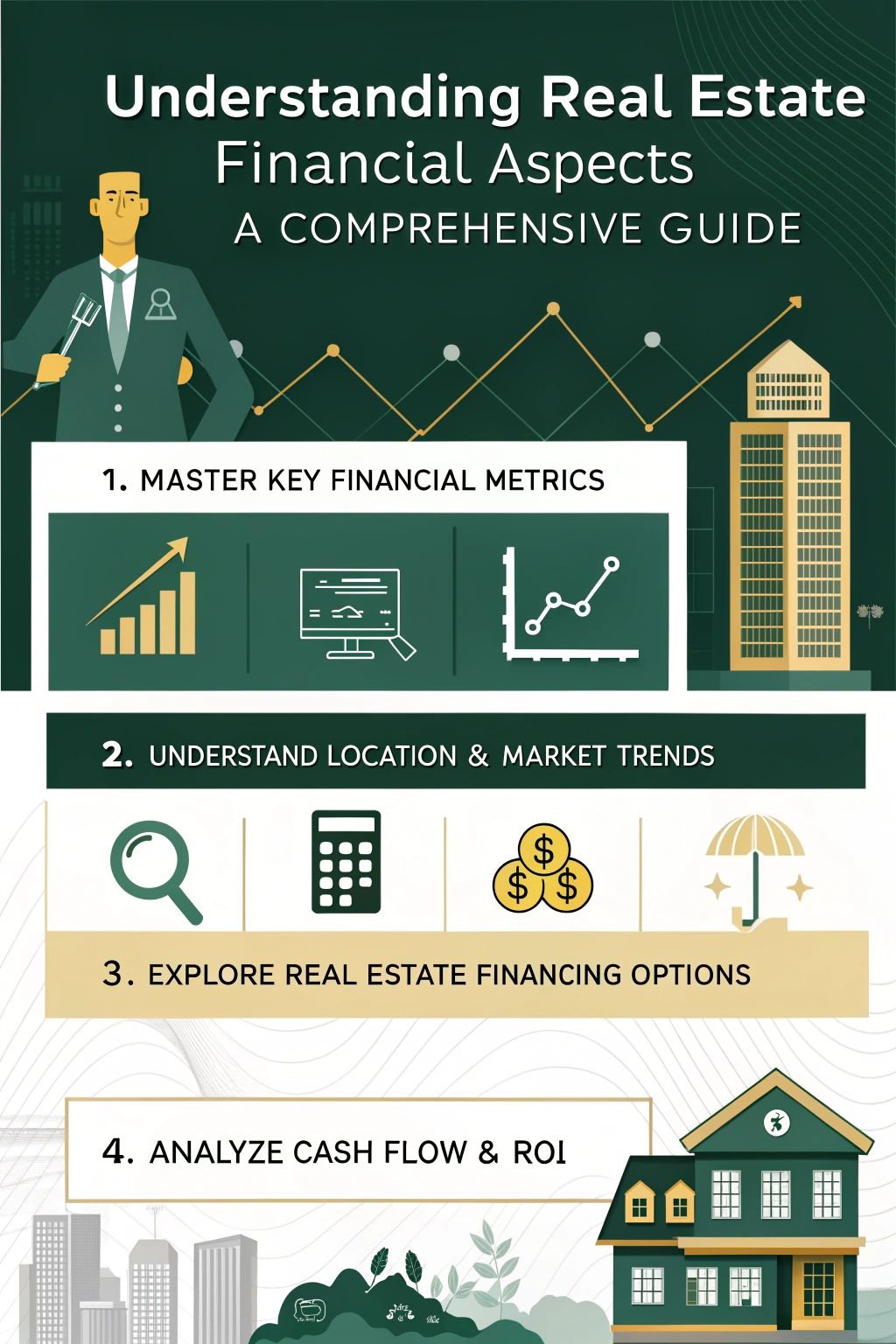Are you looking to invest in real estate but feel overwhelmed by the financial aspects? You’re not alone. Many aspiring investors struggle to make sense of the numbers and jargon involved in real estate transactions.
But fear not, because understanding real estate financial aspects is crucial for making informed investment decisions and maximizing your returns. 1
Did you know that property location is one of the most important factors influencing profitability in real estate investing? It’s true! Factors like proximity to amenities, neighborhood quality, and market trends can all impact the value and potential returns of a property. 3 In this comprehensive guide, we’ll break down the key financial concepts you need to know, from property valuation and cash flow analysis to financing options and tax considerations.
By the end of this article, you’ll have a solid foundation in real estate finance and be ready to take your investing to the next level. Let’s get started! 2
Key Takeaways
- Financial knowledge is crucial in real estate investing. It helps you make informed decisions, optimize investments, and navigate the market landscape. Key components include income statements, balance sheets, cash flow statements, rent rolls, operating expenses, debt service, cap rates, ROI, appreciation, and depreciation.
- Location and market trends significantly impact a property’s value and potential. Proximity to amenities, economic growth, and housing demand are important factors. Property valuation methods like the Sales Comparison Approach, Cost Approach, and Income Approach, along with metrics such as Cap Rate and Price-to-Rent Ratio, provide insights into a property’s financial performance and potential returns.
- Real estate financing options include traditional bank loans, government-backed mortgages (FHA, VA), seller financing, lease options, hard money loans, and partnering with other investors. Interest rates play a crucial role in affordability and market dynamics. Tools like cash flow analysis, comparative market analysis (CMA), and risk assessment are essential for evaluating potential investments and making informed decisions.
- Analyzing cash flow and return on investment (ROI) is key to assessing a property’s profitability. Important metrics include gross rental income, operating expenses, net operating income (NOI), cap rate, cash-on-cash return, and break-even point. Conducting sensitivity analysis and long-term projections helps identify risks and opportunities.
- Comparative Market Analysis (CMA) determines a property’s market value by comparing it to recently sold, similar properties in the same area. Licensed professionals use MLS data, make adjustments for differences, and provide a price range. CMAs are useful for setting listing prices, making offers, and understanding market trends. Understanding real estate financial aspects empowers you to build a diverse portfolio aligned with your goals and achieve financial freedom through informed investing.

Real Estate Financial Aspects

Financial knowledge is crucial in real estate investing. It helps you make informed decisions and maximize your returns.
Real estate financial aspects include property valuation, financing options, cash flow analysis, and tax considerations. Understanding these components is essential for success in the competitive real estate market.
Importance of Financial Knowledge in Real Estate
Financial knowledge is the bedrock of success in real estate. It empowers you to make informed decisions, optimize your investments, and navigate the ever-changing market landscape.
By understanding financial statements, such as the balance sheet, income statement, and cash flow statement, you can assess the financial health of a property and determine its potential for generating returns.
Mastering key metrics like capitalization rate, cash-on-cash return, and debt service coverage ratio allows you to compare investment opportunities and select the ones that align with your financial goals. 1
In real estate, financial knowledge is not just important, it’s essential. It’s the compass that guides you through the complex terrain of property investments. – Jay Hernandez, Chief Editor and Licensed Real Estate Broker
Moreover, financial knowledge enables you to create a robust financial plan that accounts for all aspects of your real estate venture. This includes factoring in mortgage payments, property management fees, maintenance costs, and tax implications.
By conducting thorough financial analysis, you can stress-test your investments against various scenarios and mitigate potential risks. Whether you’re a seasoned investor or a first-time homebuyer, a solid grasp of real estate finance will give you the confidence to make sound decisions and maximize your returns in this competitive industry.
Components of Financial Aspects in Real Estate
Understanding the financial aspects of real estate is crucial for making informed decisions. The key components of real estate financial aspects include:
- Income Statement: This financial statement shows the property’s revenue, expenses, and net income or loss over a specific period. It helps you assess the profitability of the investment. 2
- Balance Sheet: The balance sheet provides a snapshot of the property’s financial position at a given point in time. It lists the assets, liabilities, and equity associated with the property.
- Cash Flow Statement: This statement tracks the inflow and outflow of cash related to the property. It helps you understand the liquidity and cash generation ability of the investment.
- Rent Roll: A rent roll is a detailed list of all the tenants occupying the property, along with their lease terms, rental rates, and payment status. It provides insights into the property’s rental income potential.
- Operating Expenses: These are the ongoing costs associated with maintaining and operating the property, such as property taxes, insurance, utilities, and repairs. Analyzing operating expenses helps you determine the property’s profitability.
- Debt Service: If you finance the property with a mortgage, the debt service refers to the regular payments made towards the loan principal and interest. It’s essential to factor in debt service when evaluating the property’s cash flow.
- Capitalization Rate (Cap Rate): The cap rate is a metric used to assess the potential return on investment. It is calculated by dividing the property’s net operating income by its market value or purchase price.
- Return on Investment (ROI): ROI measures the profitability of an investment by comparing the net income generated to the initial investment. It helps you evaluate the performance of the property relative to other investment opportunities.
- Appreciation: Real estate appreciation refers to the increase in the property’s value over time. It can be influenced by factors such as location, market conditions, and property improvements.
- Depreciation: Depreciation is a tax benefit that allows you to deduct a portion of the property’s value each year to account for wear and tear. It can provide significant tax savings and improve the overall return on investment.
Factors Influencing Real Estate Investments

Location and market trends can make or break your real estate investment. Property valuation and pricing analysis help you determine if a property is a sound investment.
Location and Market Trends Impact on Property
Location and market trends play a crucial role in determining the value and potential of a property. When considering a real estate investment, it’s essential to analyze the neighborhood’s proximity to amenities, green spaces, transportation hubs, and tax zones.
These factors can significantly impact the property’s desirability and, consequently, its value. For instance, properties located near thriving business districts or popular recreational areas often command higher prices and attract more potential buyers or renters. 3
Location, location, location is the mantra of real estate for a reason. It’s the key driver of a property’s value and potential.
Moreover, staying informed about market trends in specific cities and regions can help you identify promising investment opportunities. Cities like Austin, TX, and Charlotte, NC, have shown strong economic growth and increasing demand for housing, making them attractive options for real estate investors.
By monitoring macroeconomic indicators such as GDP growth and unemployment rates, you can gain valuable insights into the overall health of a particular market and make more informed investment decisions.
Property Valuation and Pricing Analysis
Transitioning from the impact of location and market trends on property, let’s explore the crucial aspect of property valuation and pricing analysis. To make informed decisions, you need a solid grasp of the methods used to determine a property’s worth.
The Sales Comparison Approach, Cost Approach, and Income Approach are the three primary valuation techniques employed by appraisers and real estate professionals. 4 These methods take into account factors such as comparable properties, construction costs, and potential rental income to arrive at an accurate valuation.
Economic factors also play a significant role in property valuation. Interest rates and inflation can greatly influence the perceived value of a property. When interest rates are low, borrowing becomes more affordable, which can drive up demand and prices.
Conversely, high interest rates can dampen the market and lead to lower valuations. 4 As an investor, buyer, or seller, it’s essential to keep an eye on these economic indicators and understand their impact on pricing.
Key valuation metrics such as Capitalization Rate, Price-to-Rent Ratio, Gross Rent Multiplier, and Net Asset Value provide valuable insights into a property’s financial performance and potential return on investment.
Accurate valuations form the foundation of successful real estate transactions, mortgage lending, and tax assessments. Whether you’re buying a home, selling a property, or considering an investment, a thorough understanding of valuation principles and pricing analysis is indispensable.
By familiarizing yourself with these concepts and working with experienced professionals, you can make well-informed decisions that align with your financial goals. Remember, the real estate market is dynamic, and staying up-to-date with valuation trends and economic factors is crucial for navigating the competitive world of real estate.
Investment Purposes and Time Horizon
Your real estate investment goals and time horizon significantly impact your financial decisions. Are you aiming for quick profits through flipping properties or seeking long-term appreciation? Short-term investments often involve buying undervalued properties, renovating them, and selling for a profit within a few months.
This strategy requires careful market analysis, budgeting, and project management skills. On the other hand, long-term investments focus on properties with strong potential for significant appreciation over years or decades, such as well-located homes or commercial buildings in growing areas. 5
Consider your financial objectives and risk tolerance when choosing an investment approach. Flipping properties can yield substantial returns but also carries higher risks due to market fluctuations and unexpected renovation costs.
Long-term investments generally offer more stability but require patience and the ability to weather market cycles. Analyze your cash flow projections, expected expenses, and potential returns using tools like real estate financial statements and comparative market analysis to make informed decisions aligned with your goals and timeline.
Whether you’re a first-time homebuyer looking for a primary residence or an experienced investor building a diverse portfolio, understanding the interplay between your investment purposes and time horizon is crucial.
Factors such as your age, income stability, and liquidity needs should guide your strategy. For example, younger investors with steady incomes may have more flexibility to pursue longer-term appreciation, while those nearing retirement may prioritize income-generating properties for financial security.
By carefully evaluating your goals and timeline, you can develop a tailored approach that maximizes your returns and minimizes risks in the dynamic world of real estate investing.
Real Estate Financing Options
Real Estate Financing Options

Real estate financing options can make or break your investment success. From traditional bank loans to creative strategies like seller financing, the way you fund your property purchase has a huge impact on your bottom line.
Traditional Financing Methods
When exploring financing options for your real estate investment, traditional methods like conventional bank loans and government-backed mortgages are popular choices. Conventional loans from banks or credit unions typically require a higher down payment of 30% or more and have stricter credit score requirements. 7 On the other hand, FHA loans offer more lenient terms, allowing lower down payments and credit scores. For military veterans, VA loans provide competitive rates and terms tailored to their unique needs. 6
To qualify for these traditional financing options, you’ll need to provide detailed financial information, including income statements, tax returns, and credit reports. Lenders will assess your debt-to-income ratio and overall financial health to determine your eligibility and the terms of your loan.
It’s essential to shop around and compare offers from multiple lenders to find the best rates and terms for your specific situation. By understanding the requirements and benefits of each financing method, you can make an informed decision that aligns with your investment goals and financial capabilities.
Innovative Financing Strategies
Beyond traditional bank loans, you can explore innovative financing strategies to fund your real estate investments. Seller financing allows you to pay the property owner directly, often with more flexible terms than a bank. 8 Lease options give you the right to purchase a property after renting it for a set period, letting you test drive the investment before committing. Hard money loans from private lenders can provide quick cash for flipping houses or short-term projects, although they typically come with higher interest rates.
Another creative approach is partnering with other investors to pool your resources and share the risks. 8 This can help you tackle bigger deals that may be out of reach on your own.
Additionally, if you already own a home, tapping into your equity through a Home Equity Line Of Credit (HELOC) can give you access to funds for down payments or renovations on new investments.
By thinking outside the box and considering these alternative financing methods, you can open up new opportunities in the real estate market that align with your goals and financial situation.
Impact of Interest Rates on Financing
Interest rates play a crucial role in real estate financing. When interest rates are low, it becomes more affordable to borrow money for a mortgage. This can lead to increased demand for properties, driving up prices.
On the flip side, when interest rates rise, borrowing becomes more expensive. This can slow down demand and cause property values to level off or even decline. 9
As a real estate investor, it’s essential to keep a close eye on interest rate trends. Fluctuations in rates can have a significant impact on your bottom line. Higher rates mean higher mortgage payments, which can eat into your cash flow and rental income.
Lower rates, on the other hand, can boost your profitability. By monitoring interest rate forecasts and working with a knowledgeable mortgage broker, you can adapt your investment strategies to maximize returns in any rate environment.
Beyond the direct impact on financing costs, interest rates also influence the overall real estate market. In a low-rate environment, more buyers enter the market, driving up competition and prices.
As rates rise, some buyers may be priced out, leading to a cooler market. As an investor, understanding these dynamics is key to making informed decisions about when to buy, sell, or hold properties.
By staying attuned to interest rate trends and their ripple effects, you can position yourself for success in the ever-shifting real estate landscape.
Tools for Real Estate Financial Analysis

To make smart real estate investments, you need the right tools for financial analysis. Cash flow analysis, comparative market analysis, and risk assessment are essential for evaluating potential investment properties.
These tools help you determine the rate of return and profitability of a property. They also give you valuable financial insights to make informed decisions.
Analyzing Cash Flow and ROI
Analyzing cash flow and return on investment (ROI) is crucial for making informed decisions in real estate. By examining these financial metrics, you can assess the profitability and viability of a potential investment property. Here’s a detailed list of what you need to know:
- Cash flow: This refers to the net income generated by a property after all expenses, such as mortgage payments, property taxes, insurance, and maintenance costs, have been paid. A positive cash flow indicates that the property is generating more income than expenses, while a negative cash flow means the opposite.
- Gross rental income: This is the total amount of rent collected from tenants before any expenses are deducted. It’s important to have a realistic estimate of the gross rental income based on market rates and the property’s condition.
- Operating expenses: These are the ongoing costs associated with maintaining and managing the property, such as property management fees, repairs, utilities, and vacancy allowances. Accurately estimating these expenses is crucial for determining the property’s profitability.
- Net operating income (NOI): This is the annual income generated by a property after operating expenses are deducted but before mortgage payments and taxes. NOI is a key metric used to evaluate the financial performance of a real estate investment.
- Capitalization rate (cap rate): This is the ratio of a property’s NOI to its market value or purchase price. Cap rates are used to compare the relative value of different properties and to determine the potential return on investment.
- Cash-on-cash return: This metric measures the annual return on the cash invested in a property, expressed as a percentage. It’s calculated by dividing the annual pre-tax cash flow by the total cash invested.
- ROI: This is the overall return on an investment, taking into account both the cash flow and the appreciation of the property’s value over time. ROI is calculated by dividing the net profit (or loss) by the total amount invested.
- Sensitivity analysis: This involves testing different scenarios to see how changes in key variables, such as rental rates, vacancy rates, or expenses, could impact the property’s cash flow and ROI. This helps you identify potential risks and opportunities.
- Break-even point: This is the point at which the property’s income equals its expenses. Knowing the break-even point helps you determine how long it will take for the investment to become profitable.
- Long-term projections: When analyzing cash flow and ROI, it’s important to consider the property’s performance over an extended period, typically 5-10 years. This allows you to account for potential changes in market conditions, rental rates, and expenses. 10
By thoroughly analyzing a property’s cash flow and ROI, you can make more informed decisions about whether to invest in a particular property and how to optimize its financial performance. These financial metrics provide valuable insights into the potential risks and rewards of real estate investing.
Conducting Comparative Market Analysis
Comparative Market Analysis (CMA) is an essential tool for determining a property’s market value. It helps you make informed decisions when buying, selling, or investing in real estate.
- A CMA involves comparing a subject property to recently sold, similar properties in the same area. These comparable properties, or “comps,” should share similar characteristics such as location, square footage, number of bedrooms and bathrooms, and age. 11
- Licensed real estate professionals, such as brokers or appraisers, typically conduct CMAs. They have access to the Multiple Listing Service (MLS) database, which contains detailed information on properties sold in the local market.
- When selecting comps for a CMA, it’s crucial to choose properties that have sold within the past 3-6 months. This ensures the data reflects current market conditions and trends.
- Adjustments are made to the comps’ sold prices to account for differences between them and the subject property. For example, if a comp has an extra bedroom or a larger lot size, its sold price would be adjusted downward to make it more comparable to the subject property.
- Expired listings, which are properties that failed to sell, can also provide valuable insights during a CMA. They may indicate that the property was priced too high or had unappealing features to buyers.
- A CMA report typically includes a range of prices, rather than a single figure, to account for market fluctuations and unique property features. This price range helps you determine a realistic and competitive listing price for your property.
- CMAs are not only useful for setting listing prices but also for making offers on properties you wish to purchase. By understanding the market value of a property, you can negotiate more effectively and avoid overpaying.
- While CMAs provide valuable insights, they should not be confused with appraisals. An appraisal is a more formal, in-depth evaluation of a property’s value, often required by lenders during the mortgage process.
Assessing Risks and Mitigation Strategies
Assessing risks and developing mitigation strategies are crucial aspects of real estate investing. Here are some key considerations and approaches to help you navigate this process:
- Identify potential risks: Evaluate market risk, property-specific risk, financing risk, tenant risk, and legal/regulatory risk. Market risk involves factors like economic downturns or shifts in demand. Property-specific risks include issues with the physical condition or location of the property. Financing risks relate to interest rates, loan terms, and your ability to secure funding. Tenant risks involve vacancies, defaults, or property damage. Legal and regulatory risks include zoning changes, building codes, and environmental regulations. 13
- Conduct thorough due diligence: Before investing, research the property, market, and potential risks. Hire professionals to inspect the property, review financial records, and assess the local market. Analyze cash flow projections, occupancy rates, and rental comps. Investigate the property’s history, including past sales, renovations, and any legal disputes.
- Develop a risk mitigation plan: Based on your risk assessment, create a plan to minimize potential issues. This may include diversifying your portfolio across different property types and locations, maintaining adequate insurance coverage, and establishing cash reserves to cover unexpected expenses. Consider working with experienced property managers who can help mitigate tenant-related risks. 12
- Utilize technology and data analytics: Leverage tools like real estate investment software and data analytics platforms to assess risks and make informed decisions. These tools can provide insights into market trends, property valuations, and potential red flags. They can also help you track your portfolio’s performance and identify areas for optimization.
- Build a network of trusted partners: Surround yourself with a team of reliable professionals, including real estate agents, attorneys, accountants, and contractors. These experts can provide valuable insights and support in identifying and mitigating risks. Establish long-term relationships built on trust and open communication.
- Stay informed and adaptable: Keep up with changes in the real estate market, regulatory landscape, and economic conditions. Attend industry events, read relevant publications, and network with other investors to stay informed. Be prepared to adapt your strategies as new risks emerge or market conditions shift.
- Regularly review and reassess: Periodically review your portfolio and reassess your risk mitigation strategies. Monitor the performance of your investments, track market trends, and make adjustments as needed. Regularly communicate with your property managers and tenants to address any potential issues proactively.
Tax Considerations in Real Estate Investments

Tax benefits can significantly impact your real estate investment returns. Understanding the expenses related to property ownership and capital gains tax is crucial for maximizing your financial gains.
Property Ownership Tax Benefits
Owning real estate comes with several tax advantages that can significantly boost your bottom line. Depreciation allows you to recover the costs of your property over its useful life, reducing your taxable income. 14 Additionally, mortgage interest on investment properties is deductible, which can further lower your tax liability. By strategically leveraging these tax benefits, you can maximize your real estate investment returns and keep more money in your pocket.
1031 Exchanges and Opportunity Zones offer even more ways to save on taxes. 14 A 1031 Exchange enables you to defer capital gains taxes when selling an investment property and reinvesting the proceeds into a similar property.
Opportunity Zones, on the other hand, provide tax benefits like capital gains deferral and potential elimination of some capital gains taxes altogether. By understanding and utilizing these tax strategies, you can supercharge your real estate investing and achieve greater financial success.
Considerations for Capital Gains Tax
In addition to the tax benefits of property ownership, it’s crucial to consider the implications of capital gains tax when selling real estate. Capital gains are profits earned from the sale of an asset, such as a house or commercial property.
The tax rate you pay on these gains depends on how long you held the property before selling. Short-term capital gains, which apply to properties sold within a year of purchase, are taxed at your ordinary income tax rate.
On the other hand, long-term capital gains, for properties held longer than a year, are taxed at a lower rate, typically 0%, 15%, or 20%, depending on your income bracket. 15
To minimize your capital gains tax liability, you can employ various strategies. One popular approach is a 1031 exchange, which allows you to defer paying taxes on the sale of an investment property by reinvesting the proceeds into a similar property within a specified timeframe.
You can also strategically time your sales to offset gains with losses from other investments or wait until a year when your income is lower to sell. It’s essential to stay informed about legal regulations and potential changes to tax laws that could impact your real estate investments.
If you’re investing with partners, having clear agreements in place regarding the distribution of capital gains is crucial to avoid disputes down the line.
Legal and Regulatory Framework in Real Estate

Title insurance protects you against legal issues with a property’s ownership. Zoning laws limit how you can use a property.
The Role of Title Insurance
Title insurance safeguards you from potential legal problems related to property ownership. It covers hidden defects in the title, such as errors in public records, that could affect your ownership rights. 16 With a one-time payment, you get lifelong coverage against these risks.
Before closing on a property, a title search is conducted to identify any potential issues. This search looks for things like unpaid taxes, liens, or other claims against the property.
Title insurance protects you in case any of these problems surface after you’ve purchased the home. It gives you peace of mind knowing that your investment is secure.
Compliance with Zoning LawsZoning laws regulate how you can use your property. These rules aim to ensure compatible land use and guide urban growth. Zoning ordinances vary by city and county. For example, they may restrict building height, lot size, or business types allowed in an area.
As a real estate investor, buyer, or seller, you must comply with these regulations. Failing to do so could lead to fines, legal issues, or difficulty selling the property later. 17
To navigate the complexities of zoning compliance, consult with legal professionals who specialize in real estate and land use law. They can help you understand the specific zoning requirements for a property and guide you through the process of obtaining variances if needed.
A variance is a special permission that allows you to deviate from certain zoning rules. Applying for one requires presenting a strong case to the local zoning board. With proper due diligence and expert guidance, you can ensure your real estate investments and transactions align with all applicable zoning laws.
Approaches to Real Estate Investment

When comparing residential and commercial properties, consider your investment goals and risk tolerance. Investing in REITs can provide exposure to the real estate market without the hands-on management responsibilities.
Comparing Residential and Commercial Properties
When comparing residential and commercial properties, you’ll find some key differences. Residential properties are homes, apartments, or condos where people live. Lease terms are usually one year.
In contrast, commercial properties are offices, retail spaces, or warehouses leased to businesses. These leases span 3-5 years on average. Zoning laws are stricter for commercial buildings. 18
You’ll also notice financial differences between these two property types. Commercial loans have higher interest rates and require larger down payments than residential mortgages. Property taxes are also higher for commercial real estate.
When analyzing potential returns, consider that commercial tenants are businesses while residential tenants are individuals or families. This impacts factors like turnover rate and maintenance needs.
Ultimately, your investment goals will guide whether residential or commercial properties are the right fit for your portfolio. Residential real estate may offer more stable cash flow, while commercial properties have the potential for higher returns but also come with more risk.
Assess your financial position, risk tolerance, and time horizon to determine which path aligns best with your strategy. With careful research and due diligence, you can build a strong real estate portfolio in either sector.
Investing in Real Estate Investment Trusts (REITs)
Real estate investment trusts (REITs) offer a unique way to invest in real estate without directly owning property. REITs are companies that own and operate income-generating real estate, such as apartments, shopping centers, and office buildings.
By investing in REITs, you can gain exposure to a diverse portfolio of properties and benefit from the potential for regular income and long-term capital appreciation. According to “Educated REIT Investing: The Ultimate Guide” by Wiley, published in October 2020, REITs can provide attractive returns and help diversify your investment portfolio. 19
When considering REITs, it’s essential to understand the different types available and their specific characteristics. Equity REITs, for example, own and manage properties, while mortgage REITs invest in real estate loans and securities.
You should also evaluate factors such as the REIT’s management team, financial stability, and growth prospects. By conducting thorough research and consulting with financial professionals, you can make informed decisions about incorporating REITs into your investment strategy.
As you explore the potential of REITs, let’s move on to the next topic: financial challenges in real estate investing.
Financial Challenges in Real Estate Investing

Over-leveraging is one of the biggest risks in real estate investing. It can lead to financial distress if the market takes a downturn or if rental income doesn’t cover the mortgage payments.
Another challenge is managing cash flow effectively. You need to ensure that you have enough money coming in from rent or other sources to cover all your expenses, including mortgage payments, property taxes, insurance, and maintenance costs.
Risks of Over-Leveraging
Over-leveraging can be a major pitfall when investing in real estate. When you borrow too much money to finance a property, you put yourself at risk of defaulting on the loan if market conditions change or unexpected expenses arise.
Experts recommend keeping your loan-to-value (LTV) ratio below 80% to maintain a safety cushion. Borrowing 100% of the purchase price may seem tempting, but it often comes with higher interest rates and substantial fees that eat into your profits. 20
Another danger of over-leveraging is the potential for negative equity if housing prices decline. Let’s say you buy a $300,000 home with a 100% LTV mortgage. If the market value drops to $250,000, you now owe more than the property is worth.
This scenario can make it difficult to sell or refinance without taking a significant loss. To mitigate this risk, consider making a larger down payment and maintaining an emergency fund to cover unforeseen costs.
By being conservative with your leverage, you can weather market fluctuations and protect your investment for the long term.
Managing Cash Flow Effectively
Effective cash flow management is crucial for your success as a real estate investor. To stay on top of your game, you need to keep a close eye on your rental income, operating expenses, and financing costs. 21 Utilizing property management software can help you monitor your cash flow in real-time, giving you the insights you need to make informed decisions. This technology allows you to track your revenue and expenses, so you can quickly identify areas where you may be overspending or underperforming.
Another strategy for managing your cash flow is strategic refinancing. By refinancing your mortgage at a lower interest rate, you can reduce your monthly payments and free up more cash for other investments or expenses.
This approach can be especially helpful if you’re looking to expand your portfolio or take on a new project. Just be sure to carefully consider the terms of any new loan and factor in any closing costs or fees before making a decision.
Positive cash flow is the key to profitability in real estate investing. It means that you’re generating more revenue than you’re spending on expenses. To achieve this, you need to have a solid understanding of your rental income potential, as well as your operating costs and financing expenses.
By carefully analyzing these factors and making smart decisions about where to allocate your resources, you can ensure that your investments are generating the returns you need to succeed in this competitive industry.
Strategies for a Diverse Real Estate Portfolio

A diverse real estate portfolio can help you spread risk and maximize returns. By investing in different property types, locations, and strategies, you can build a well-rounded portfolio that weathers market fluctuations.
Balancing Different Types of Real Estate Investments
Balancing different types of real estate investments is crucial for a well-rounded portfolio. By diversifying your investments, you can spread risk and potentially increase returns. Here are some key strategies to consider:
- Mix residential and commercial properties: Investing in both residential (single-family homes, apartments) and commercial (office buildings, retail spaces) properties can provide a balance of steady rental income and potential for capital appreciation. 22
- Consider REITs: Real Estate Investment Trusts (REITs) allow you to invest in a variety of properties without directly owning them. REITs can offer liquidity and diversification across different sectors and geographies.
- Vary investment strategies: Combine long-term buy-and-hold investments with shorter-term fix-and-flip or wholesaling deals. This mix can provide both stable cash flow and potential for higher returns.
- Diversify by location: Invest in properties across different markets and regions to mitigate the impact of local economic fluctuations. Consider factors like population growth, job market, and infrastructure development when selecting locations.
- Assess risk and return: Evaluate each investment opportunity based on its potential return and associated risks. Higher-risk investments, such as development projects, may offer greater returns but also carry more uncertainty.
- Regularly review and rebalance: Periodically assess your portfolio’s performance and make adjustments as needed. Rebalance your investments to maintain your desired level of diversification and align with your overall investment goals.
By implementing these strategies, you can create a well-balanced real estate investment portfolio that aligns with your financial objectives and risk tolerance. Exploring out-of-state investment opportunities can further diversify your holdings and potentially tap into new growth markets.
Exploring Out-of-State Investment Opportunities
Expanding your real estate portfolio beyond your local market can offer exciting opportunities for growth and diversification. Out-of-state properties often provide higher rental yields and appreciation potential compared to saturated markets.
Online platforms like Zillow and Roofstock make it easier than ever to find and analyze investment properties in different cities and states. You can access detailed property information, market data, and even virtual tours from the comfort of your home. 23
Before taking the plunge, it’s crucial to conduct thorough research on the target market. Understand the local economy, job growth, population trends, and rental demand. Familiarize yourself with the state and local laws regarding property ownership, taxes, and landlord-tenant regulations.
Networking with local real estate professionals can provide valuable insights into the market dynamics and help you make informed decisions. Once you’ve identified a promising property, consider hiring a reputable property management company to handle the day-to-day operations, tenant screening, and maintenance.
This allows you to invest in out-of-state properties without the hassle of long-distance management.
Diversifying your real estate investments across different markets can help mitigate risks and optimize returns. By spreading your investments geographically, you can take advantage of varying market cycles and economic conditions.
While one market may experience a slowdown, another may be thriving, providing a buffer for your overall portfolio. Additionally, investing in different property types, such as single-family homes, multi-family units, or commercial properties, can further diversify your holdings and cater to different tenant preferences.
As you expand your real estate footprint, it’s essential to maintain a balanced and strategic approach to ensure long-term success.
Conclusion
Understanding real estate financial aspects is key to your success. You now have the tools to analyze investments, assess risks, and make informed decisions. With this knowledge, you can build a diverse portfolio that aligns with your goals.
Take action today and start your journey to financial freedom through real estate.
FAQs
1. Why is financial reporting crucial in the real estate industry?
Financial reporting helps real estate professionals and investors make informed decisions by providing accurate and up-to-date financial data. It’s an essential tool for understanding the financial health and performance of real estate projects, allowing stakeholders to assess risks, identify opportunities, and optimize returns.
2. What are the key components of real estate financial statements?
Real estate financial statements typically include a balance sheet, income statement, and cash flow statement. These documents provide a comprehensive overview of a property’s financial position, including assets, liabilities, revenues, expenses, and cash flows. Understanding these components is crucial for effective financial management in the real estate sector.
3. How can financial analysis enhance real estate investment decisions?
Financial analysis in real estate enables investors to evaluate the potential profitability and risk of a property. By examining financial ratios, such as return on investment (ROI) and debt-to-equity ratio, investors can assess the viability of a real estate investment and make informed decisions based on their investment goals and risk tolerance.
4. What role does risk assessment play in real estate financial management?
Risk assessment is a critical aspect of real estate financial management. It involves identifying, evaluating, and mitigating potential risks that may impact the financial performance of a real estate investment. By conducting thorough risk assessments, real estate professionals can develop strategies to minimize exposure to financial risks and optimize returns.
5. How can understanding the complexities of real estate finance benefit investors?
Navigating the intricate financial landscape of real estate can be challenging, but a solid understanding of the basics can give investors a significant advantage. By familiarizing themselves with concepts such as capitalization rates, net operating income, and cash flow projections, investors can make more informed decisions and potentially maximize their returns.
6. What factors influence the profitability of a real estate investment?
Several key factors contribute to the profitability of a real estate investment, including location, market conditions, property type, and financing structure. Additionally, the ability to generate steady rental income and appreciate in value over time are important considerations. By carefully analyzing these factors and conducting thorough financial due diligence, investors can identify properties with the greatest potential for long-term profitability.
References
- ^ https://gallaghermohan.com/blogs/understanding-the-importance-of-financial-analysis-in-real-estate-investments/ (2024-02-23)
- ^ https://www.outsourcinghubindia.com/understanding-real-estate-financial-statements-a-comprehensive-guide/
- ^ https://www.rentastic.io/blog/real-estate-investment-returns-impact-of-location
- ^ https://www.girolino.com/understanding-the-fundamentals-of-real-estate-valuation-a-comprehensive-guide-for-investors/
- ^ https://www.investopedia.com/articles/investing/110614/most-important-factors-investing-real-estate.asp
- ^ https://pce.sandiego.edu/14-real-estate-financing-options-guide-faqs/
- ^ https://www.investopedia.com/articles/investing/021016/complete-guide-financing-investment-property.asp (2024-06-17)
- ^ https://www.nasdaq.com/articles/12-creative-financing-strategies-real-estate-investing (2024-09-18)
- ^ https://www.straightupchicagoinvestor.com/blog/understanding-interest-rates-and-their-impact-on-real-estate-investors
- ^ https://library.fiveable.me/introduction-to-real-estate-finance/unit-5/investment-property-cash-flow-analysis/study-guide/9EXKNHhoeml41F0n (2024-08-14)
- ^ https://www.rocketmortgage.com/learn/comparative-market-analysis
- ^ https://library.fiveable.me/introduction-to-real-estate-finance/unit-5/risk-assessment-management-real-estate-investment/study-guide/5G11XpNrWadkrSiS (2024-08-14)
- ^ https://toljcommercial.com/mitigating-risks-in-real-estate-investments/
- ^ https://www.lewis.cpa/blog/tax-benefits-of-real-eastate-investing (2024-05-27)
- ^ https://connect.janover.co/blog/real-estate-capital-gains-your-comprehensive-guide/
- ^ https://jayjohnsonlawfirm.com/the-role-of-title-insurance-in-protecting-your-property-investment/
- ^ https://www.realestatelawcorp.com/land-use-and-zoning-in-real-estate-law-understanding-the-regulatory-framework-and-legal-implications/
- ^ https://www.commercialrealestate.loans/blog/commercial-vs-residential-real-estate-guide/ (2023-02-19)
- ^ https://www.amazon.com/Educated-REIT-Investing-Intelligent-Investor/dp/1119708699
- ^ https://www.bestevercre.com/blog/the-dangers-of-over-leveraging-understanding-the-risks-of-100-financing-for-real-estate-investors
- ^ https://mksh.com/how-to-optimize-cash-flow-for-real-estate-investors-accounting-tips-for-2024/
- ^ https://www.linkedin.com/pulse/understanding-real-estate-investments-comprehensive-guide-sathaiya-0xule
- ^ https://goodegginvestments.com/blog/out-of-state-real-estate-investing/ (2024-01-26)




















